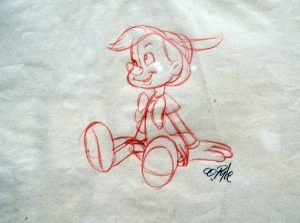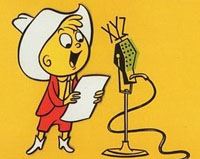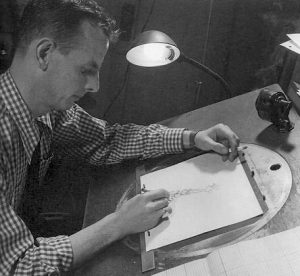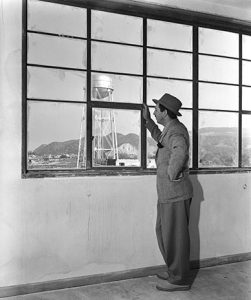Willis Pyle (September 3rd, 1914 – June 2th, 2016) was one of the many journeyman animators who produced strong animation and worked at a variety of studios over the decades. His brother was actor Denver Pyle known for his work in television like the Dukes of Hazzard series.
Pyle worked at Disney and UPA and later enjoyed a long career as a freelance animator on such projects as Raggedy Ann and Andy: A Musical Adventure (1977), Halloween is Grinch Night (1977), several Peanuts television specials, Cathy’s Valentine (1977) and more.
Many animators like Willis have some terrific stories about animation and the people they worked with but most of those tales have never been shared in print. One of the reasons I do these “In His Own Words” installments is an attempt to preserve some of these memories and share them with a wider audience.
When reading these installments, it is important to remember that these are the memories and perspectives of the person and may not always align with other people’s memories and perspectives or even chronological facts.
Willis Pyle: I started out as an assistant to Milt Kahl on Pinocchio at Disney. He would give me a scene of his roughs and I would finish up his work and send it to the camera for pencil tests. And I worked with Phil Duncan.
 I worked on Pinocchio when he was in the bird cage and when he says, “I have a conscience.” I worked on the scene when Jiminy Cricket was running, putting on his coat, trying to catch Pinocchio. After Pinocchio, I worked on Fantasia, on Beethoven’s Pastoral Symphony and concentrated mostly on the cupids.
I worked on Pinocchio when he was in the bird cage and when he says, “I have a conscience.” I worked on the scene when Jiminy Cricket was running, putting on his coat, trying to catch Pinocchio. After Pinocchio, I worked on Fantasia, on Beethoven’s Pastoral Symphony and concentrated mostly on the cupids.
Then I worked on the scenes of the adolescent Bambi for that film and then there was the strike at the studio. I really hated going out on strike but I couldn’t have stayed in because of the people I would have passed on the picket line. I was sympathetic to the idea of a union. I felt the union was necessary because there was no rhyme or reason as to the way guys were paid. My personal feeling was that there should be some kind of a plan to it all.
They offered me my old job back after the war and I had been animating for four years in the Army in the First Motion Picture Unit Army Air Corp under Disney animator Frank Thomas who did the direction so I had quite a lot of experience behind me. We did training films like Trigger Joe who was a tail gunner.
My old job back at Disney’s was as an assistant at fifty bucks a week but because of my experience I was offered a job animating at one hundred and fifty bucks a week. I was married so I needed the dough.
 Later I started around 1946 at UPA and left in 1950. I didn’t leave because of any hard feelings. I left because I wanted to come to New York. My wife was in favor of it too.
Later I started around 1946 at UPA and left in 1950. I didn’t leave because of any hard feelings. I left because I wanted to come to New York. My wife was in favor of it too.
I worked on the first Mr. Magoo cartoon and on Gerald McBoing Boing. On Magoo, John Hubley was the designer. He may have put down something on Magoo but Magoo was designed by the animators. That would be Art Babbitt, myself and possibly Rudy Larriva. I think that’s the way the character evolved.
While I probably had quite a lot to do with the development of Mr. Magoo, there were other animators working on him, too. So what we did was select some of my drawings and then I might pick up someone else’s drawings and change them slightly or they might take one of my drawings and change it slightly to make a model sheet.
 When you start out you have a drawing then after the character is animated it becomes a “personality”. It takes on a life of its own. You’ll be sitting in a story conference and you’ll hear someone say, “But Magoo wouldn’t do this!” or “That’s not Magoo.” The reason that they say this is because Magoo has taken on a personality and the personality came from the animators.
When you start out you have a drawing then after the character is animated it becomes a “personality”. It takes on a life of its own. You’ll be sitting in a story conference and you’ll hear someone say, “But Magoo wouldn’t do this!” or “That’s not Magoo.” The reason that they say this is because Magoo has taken on a personality and the personality came from the animators.
Jim Backus who did the voice adds a lot to the character. The voice suggests a lot of what a character is like. Magoo was pompous. He was very self important. I remember they gave me a scene because I was the only animator who ever belonged to a fraternity. Magoo says, “Give me the old grip” and he takes his hand and starts pumping and this guy is flopping all over the place. Magoo sort of overdid everything.
I’ve been in this business a long time. I always felt very fortunate that Walt (Disney) gave me a chance. In 1937, there was a big depression and everybody was wondering what they were going to do for work. He used to tell the animators not to show it to him until they were satisfied with it, not to feel rushed.
I did the best I could and took the time that was necessary and I never had any complaints about working too slow. I think the greatest animator that I ever worked with was Frank Thomas. I spent four years with him in the army. He was the director and he gave me some excellent training as far as animation is concerned.
I didn’t work directly with Walt. He used to speak to me in the hall. That’s about it. He was mostly associated with the story department and he was generally going around looking at storyboards. He was always very friendly.
I had been in Hollywood about six or eight months and my sister was teaching school in Colorado. During her vacation she came out to Hollywood to see me.
We were still at the old studio on Hyperion when she came out but Disney was building their new studio over in Burbank. It was a Sunday afternoon and I asked her if she would like to see the new studio. The walls were up but there were no windows and there was no roof, just long, dark hallways and a lot of fresh cement smell.
We were walking in one of these hallways and somebody calls out, “Who is it?” I had been at Disney such a short time that I was reluctant to give my name because who would’ve ever heard of Willie Pyle? But I said, “Willie Pyle”. Then the voice said, “Come on down.”
So my sister and I walked down to the end of the hall and, of course, it was Walt. I introduced my sister and he said, “Come on. I want to show you my studio.” He spent the whole afternoon showing us where everything was going to be. So after that, he remembered me and was always very friendly.




 Jim Korkis is an internationally respected animation historian who in recent years has devoted his attention to the many worlds of Disney. He was a columnist for a variety of animation magazines. With his former writing partner, John Cawley, he authored several animation related books including The Encyclopedia of Cartoon Superstars, How to Create Animation, Cartoon Confidential and Get Animated’s Animation Art Buyer’s Guide. He taught animation classes at the Disney Institute in Florida as well as instructing classes on acting and animation history for Disney Feature Animation: Florida.
Jim Korkis is an internationally respected animation historian who in recent years has devoted his attention to the many worlds of Disney. He was a columnist for a variety of animation magazines. With his former writing partner, John Cawley, he authored several animation related books including The Encyclopedia of Cartoon Superstars, How to Create Animation, Cartoon Confidential and Get Animated’s Animation Art Buyer’s Guide. He taught animation classes at the Disney Institute in Florida as well as instructing classes on acting and animation history for Disney Feature Animation: Florida.




















































According to his obituary, Willis Pyle was at the Walter Lantz studio for six months after his discharge from the army, working on Woody Woodpecker cartoons. I’m not aware that he’s credited on any of them. Pyle was, however, a credited animator on the little-known independent cartoon “Honesty Is the Best Policy” (1946). Like all the principal artistic talent behind that cartoon, he’s caricatured in the opening credits.
The Mister Magoo cartoon with the fraternity handshake is “Trouble Indemnity” of 1950. I suspect that Pyle belonged to an art fraternity that didn’t have a secret handshake, much less hazing rituals or toga parties.
When did you interview Willis Pyle? He must have been one of the last surviving artists who worked on Pinocchio, Fantasia and Bambi. The man lived to be 101!
These miniature “oral histories” are priceless. A real service. Thanks.
I wish you coulda had a reel, though.
I’m going to have to go backwards and catch all of these. This series is wonderful. Thank you.
I agree! I hope you keep publishing these in some form, Jim! They need to be preserved in print – one way or another!
Speaking of that, my manuscript was finally approved over at BearManor books, so my own interviews and articles on animation will – hopefully – see print later this year!
I recall Pyle being featured several times on CBS Sunday Morning in the late 2000’s showing his drawing of Pinocchio.
Speaking of that network, here’s one of R. O. Blechman designed Christmas CBS station IDs that Pyle himself animated: https://www.youtube.com/watch?v=wcAKhLUtbpM